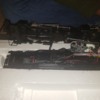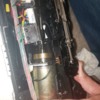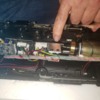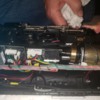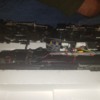I am aware the fix to this is to drill a hole through the coupling, but is there any other method that works just as well? I am not that comfortable with putting a hole through the drive shaft.
Replies sorted oldest to newest
CONTEXT: Motor spins, but shaft doesn't move, seems the coupling for the shaft is stripped
If the flywheel is spinning, then you've likely stripped the cheap plastic dogbone. If the flywheel is not spinning, then you just need to tighten the flywheel screw(s).
Common ailment for this engine. I’ve fixed oodles of these. If you’re uncomfortable drilling the coupling, but you can remove the driveshaft, you can reach out to me via profile. The coupling on the gear box end is known to work loose and spin. The proper repair is to drill and tap the coupling for a set screw, one & done. Glue and or adhesives would only be a bandaid in this situation. All the motor torque is dumped on that coupling. Best to have a mechanical repair.
Pat
@harmonyards posted:Common ailment for this engine. I’ve fixed oodles of these. If you’re uncomfortable drilling the coupling, but you can remove the driveshaft, you can reach out to me via profile. The coupling on the gear box end is known to work loose and spin. The proper repair is to drill and tap the coupling for a set screw, one & done. Glue and or adhesives would only be a bandaid in this situation. All the motor torque is dumped on that coupling. Best to have a mechanical repair.
Pat
That actually sounds like a repair that I could accomplish. ![]()
@gunrunnerjohn posted:That actually sounds like a repair that I could accomplish.
Pretty simple, …slide the cup off, Chuck it up in a vise, drill and tap for a 4-40 ( or whatever your favorite flavor of set screw is ) clear the bore of the cup of debris, slide the cup back on, and tighten the set screw…..reassemble, done ….😁
Pat
I'm a metric man lately, so it would probably be a 3mm screw. ![]()
![]()
Pat and John.
I might take you up on repair of the 2 EM1 drive shafts I have comes spring/summer when you have more available for repair work. The one on my engine has been good all these years but I don’t run 50 cars behind it!
@harmonyards posted:Pretty simple, …slide the cup off, Chuck it up in a vise, drill and tap for a 4-40 ( or whatever your favorite flavor of set screw is ) clear the bore of the cup of debris, slide the cup back on, and tighten the set screw…..reassemble, done ….😁
Pat
Do I need a 1/4" or 1/8" 4-40 set screw? Also, would I be drilling through only the coupling or the driveshaft as well?
@JJScholten posted:Do I need a 1/4" or 1/8" 4-40 set screw? Also, would I be drilling through only the coupling or the driveshaft as well?
1/8” will be fine. Process as follows. Grasp the cup and twist off the shaft. Drill through 1/2 of the cup on the backside edge, but not too close to the edge, as you can easily cut through accidentally. Tap the hole for 4-40 thread. De-bur the bore, and place back on the shaft. Install set screw, and tighten.
Pat
@harmonyards posted:1/8” will be fine. Process as follows. Grasp the cup and twist off the shaft. Drill through 1/2 of the cup on the backside edge, but not too close to the edge, as you can easily cut through accidentally. Tap the hole for 4-40 thread. De-bur the bore, and place back on the shaft. Install set screw, and tighten.
Pat
Hi Pat,
I have used Locktite Red and had no issues after that. If he does not want to drill it’s a thought
Checkout Norm Charboneau on You Tube. He did an excellent step by step tutorial on this engine at the workbench adding a set screw.
@ThatGuy posted:Hi Pat,
I have used Locktite Red and had no issues after that. If he does not want to drill it’s a thought
If you're going to use Loctite for the repair you want to use one of their retaining compounds, like Loctite 680, as it's meant for press fit applications. Red Loctite is for holding screws in place, not press fit components.
Yep, Loctite 680 is my go-to nowadays for jobs like this.
However, I vastly prefer the setscrew approach, that makes it easy to disassemble for maintenance. I might even take a page from Lionel's book for some of their flywheels and drill the hole all the way through to have two setscrews, one from each side.
All of the torque of the Pittman motor vs. the EM1’s monstrous drive train is unloaded right on that coupling!…..color me funny, but I want a mechanical repair here…….plus, the set screw will allow some adjustability if the cup is too close, or too far away, & possibly damaging the dog bone. Y’all set it with retaining compound, and you get one chance to get it right, ….if it’s not, you’re in for a fight. ….
Pat
@harmonyards posted:All of the torque of the Pittman motor vs. the EM1’s monstrous drive train is unloaded right on that coupling!…..color me funny, but I want a mechanical repair here…….plus, the set screw will allow some adjustability if the cup is too close, or too far away, & possibly damaging the dog bone. Y’all set it with retaining compound, and you get one chance to get it right, ….if it’s not, you’re in for a fight. ….
Pat
Your correct a mechanical connection is always best. But for many people without the proper tools loctite is the only choice. While blue and red are for fasteners it will allow for some mistakes to be made. Red can be used for the on shaft slipping if done right. In all of this patience is key.
What tools? A drill and a 4-40 tap looks like all the tools required. OK, those are tools, but not exactly out of reach for most folks willing to go in and attempt this repair.
While you can use the thread locker, the shaft can't have any gap with thread locking compound. The retaining compound allows for a slightly looser fit while still doing the job with no tools.
@ThatGuy posted:Your correct a mechanical connection is always best. But for many people without the proper tools loctite is the only choice. While blue and red are for fasteners it will allow for some mistakes to be made. Red can be used for the on shaft slipping if done right. In all of this patience is key.
Suggesting this could get somebody in trouble. If they use the improper locking compound, it’s a mess, if they use the correct locking compound and make a mistake installing it, then it’s a bigger mess, …..folks like myself charge more for making a mess out of something first!….( more time to straighten it all out??…..no??) ……if folks are uncomfortable around tools, then contact someone like me, or the others on this forum that can make a competent repair the first time, …..that saves money and grief in the long run, …….yes??
Pat
@harmonyards posted:Suggesting this could get somebody in trouble. If they use the improper locking compound, it’s a mess, if they use the correct locking compound and make a mistake installing it, then it’s a bigger mess, …..folks like myself charge more for making a mess out of something first!….( more time to straighten it all out??…..no??) ……if folks are uncomfortable around tools, then contact someone like me, or the others on this forum that can make a competent repair the first time, …..that saves money and grief in the long run, …….yes??
Pat
While I agree in principle, reality is running against economics. Today many people no longer have the cash to send it out and get it fixed. I repair clocks and I see this every day with people who used to drop it off and say “just fix it” money is tight . The time of free money is coming to an end. I was privileged to see some real numbers on shipping within our hobby. The numbers are very low overall.
I now use a new (old) version of bushing replacements for clocks that do not need a complete disassembly. Do I want to…….no but people cannot pay to have the complete job done.




